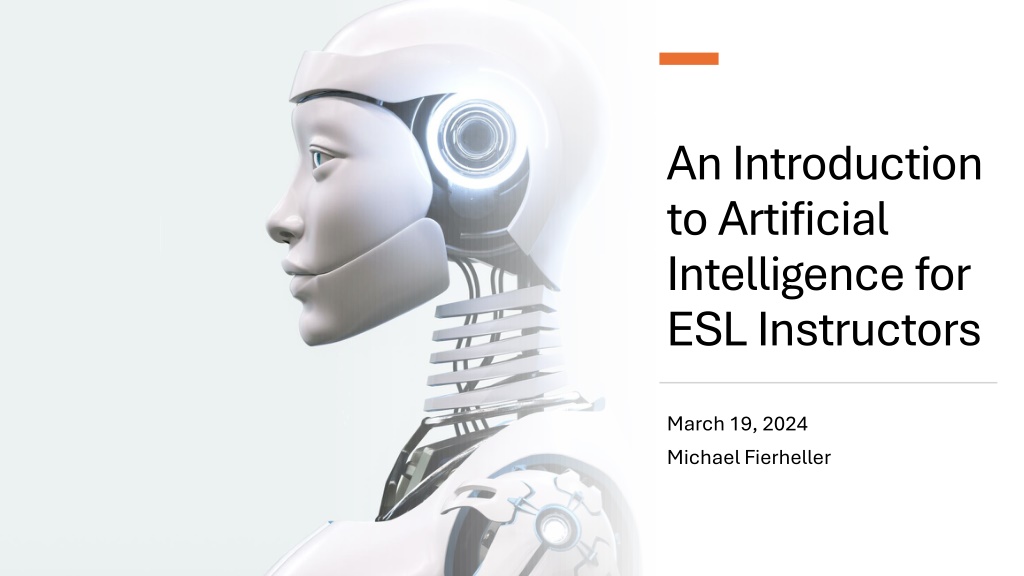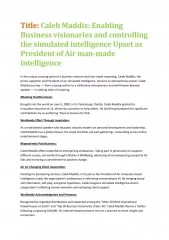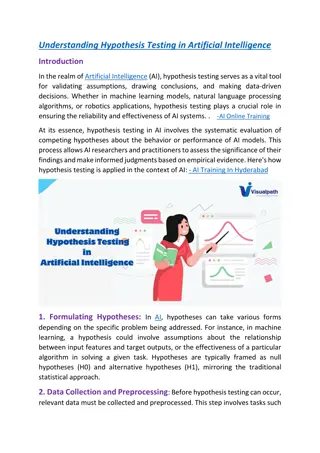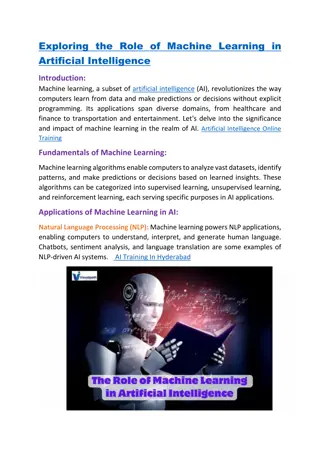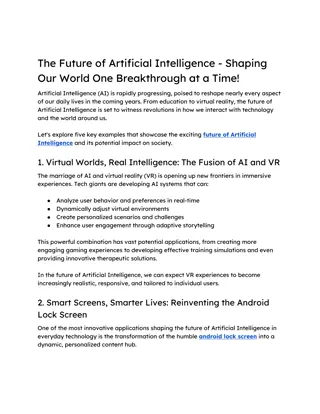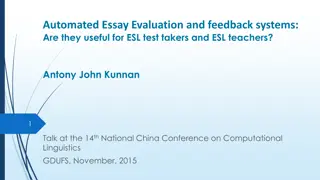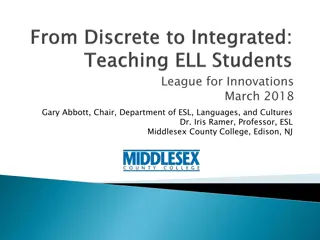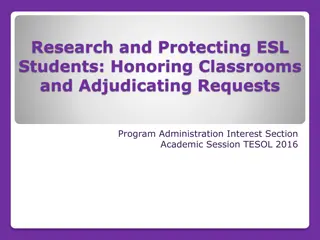Exploring Artificial Intelligence in ESL Education
This resource delves into the realm of artificial intelligence (AI), focusing on its applications in ESL instruction. It covers what AI is, its benefits for individualized learning, limitations, and the role of Large Language Models (LLMs) in text prediction and processing. The content also discusses AI's potential in personalized and self-directed learning, as well as its use as a speaking/texting partner, example generator, writing assistant, tutor, and self-study resource in ESL settings.
- Artificial Intelligence
- ESL Education
- Individualized Learning
- Large Language Models
- Self-directed Learning
Download Presentation

Please find below an Image/Link to download the presentation.
The content on the website is provided AS IS for your information and personal use only. It may not be sold, licensed, or shared on other websites without obtaining consent from the author. Download presentation by click this link. If you encounter any issues during the download, it is possible that the publisher has removed the file from their server.
E N D
Presentation Transcript
An Introduction to Artificial Intelligence for ESL Instructors March 19, 2024 Michael Fierheller
Overview What is artificial intelligence (AI)? AI for individualized and self- directed learning AI for saving time Limitations and concerns Trent-ESL 2024 2
What do we mean by artificial intelligence? Large Language Models (LLM) Text predictors Trained on huge amounts of text data https://copilot. microsoft.com https://gemini. google.com/ https://chat.openai.com Trent-ESL 2024 3
What can LLMs do? Generate coherent responses to various prompts Preform language processing tasks Translation Summarization Writing an array of texts Trent-ESL 2024 4
What cant LLMs do (yet)? Use common sense or real- world knowledge beyond their training Understand context beyond the information they are provided Remember much of an ongoing conversation Be creative Trent-ESL 2024 5
AI for Individualized and Self-directed Learning Personalized Learning Activities can be optimized for the needs and interests of each student Self-directed Learning Students can have greater autonomy over what and how they are learning Trent-ESL 2024 6
AI as a Speaking or Texting Partner Google Gemini ChatGPT + Voice Control for ChatGPT (Chrome Extension) Trent-ESL 2024 7
AI for Generating Examples ChatGPT Microsoft CoPilot Trent-ESL 2024 8
AI as a Writing Assistant or Tutor ChatGPT Microsoft CoPilot Trent-ESL 2024 9
AI for Self-study Resources Microsoft CoPilot Google Gemini Trent-ESL 2024 10
AI for Saving Time Lesson Plans Creating Materials Suggesting Activities and Vocabulary Creating Activities Proofreading and Feedback Marking Trent-ESL 2024 11
Lesson Plans and Outlines ChatGPT Trent-ESL 2024 12
Creating Materials Microsoft CoPilot Trent-ESL 2024 13
Suggesting Activities and Vocabulary ChatGPT Microsoft CoPilot Trent-ESL 2024 14
Generating Activities ChatGPT Trent-ESL 2024 15
Proofreading and Feedback ChatGPT Google Gemini Trent-ESL 2024 16
Marking Microsoft Copilot ChatGPT Trent-ESL 2024 17
Limitations and Concerns Loss of personal connection with students Bias in the algorithm Accuracy and quality control Loss of creativity and personalization Security and privacy Trent-ESL 2024 18
Additional Resources What is Artificial Intelligence? | Quick Learner How is artificial intelligence (AI) used in education? Education in the age of AI (Artificial Intelligence) | Dale Lane | TEDxWinchester 10 Powerful AI Tools for Language Teachers 7 AI Tools That Help Teachers Work More Efficiently Artificial intelligence in language instruction: impact on English learning achievement, L2 motivation, and self-regulated learning Exploring the Application of Artificial Intelligence in Foreign Language Teaching: Challenges and Future Development Using Artificial Intelligence for Foreign Language Learning Essentials of Artificial Intelligence for Language Learning How artificial intelligence is revolutionizing language learning Trent-ESL 2024 19
